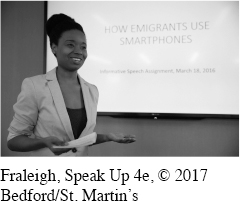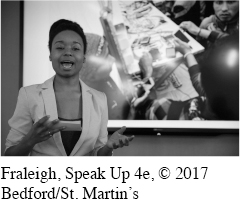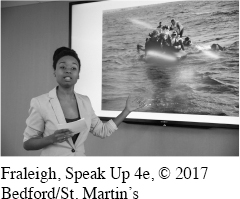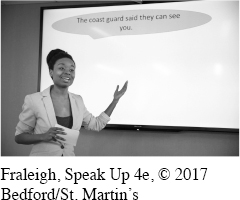 How Emigrants Use Smartphones: Full-Length Speech
How Emigrants Use Smartphones: Full-Length Speech

Imagine that you are a refugee from a war-

Today, we’ll take a look at how smartphones are central to the success of emigrants’ journeys. Many members of this class have their own stories of how their families came to the United States. And most of you are very familiar with a multitude of apps on your own smartphones. So let’s put these two ideas together and see why smartphones are so useful for migrants. I have always been interested in my own family’s story of emigration through Europe and on to North America and have been fascinated while researching the twenty-
Page A-10

Smartphones are one of the most important possessions of many college students, and our class surveys indicated that many of you spend hours each day on yours. Smartphones are even more vital for emigrants. Hannah Kozlowska, staff reporter for Quartz, indicated on September 14, 2015, that “more than a billion people around the world rely on smartphones and their ubiquitous messaging and social media apps, but none more so than the hundreds of thousands of people who are fleeing war, hunger, and famine in the Middle East and Africa.”
In an October 9, 2015, MTV News article, Melita Šunjić, a United Nations Relief and Works Agency senior public information officer, stated that at refugee camps, emigrants not only ask about where to eat and sleep but also “where they can get WiFi” and “is it possible to help them charge their phones.”
For example, a music teacher named Osama Aljasem, who migrated from Syria to Belgrade, Serbia, told the New York Times on August 25, 2015, that “every time I go to a new country, I buy a SIM card and activate the Internet and download the map to locate myself.” Mr. Aljasem acknowledges that “I get stressed out when the battery even starts to get low.”

The need for Internet access can spur creative solutions. When refugees experienced connectivity problems after crossing the border into Croatia, Louise Dewast, a digital news associate for ABC News, described a unique fix on September 22, 2015. Otvorena Mreža (Project Open Network), a tech start-
Now that you have seen that many emigrants rely on smartphones, let’s take a look at how and why these phones are so helpful.
Page A-11
Imagine that you have just arrived in a country for the first time and you need to cross it on your journey. You don’t speak the language, could be all alone, have no local currency, and don’t know where you can stay or how to travel safely. What apps on your phones might you use? Don’t say “Order a pizza” because the closest Domino’s is over one hundred miles away and they won’t deliver. And what new apps would you download before you left? Your phone could be your lifeline.
Communicating with family members is one important use of smartphones. In Time magazine, October 19, 2015, news photographer Patrick Witty tells the story of Rami Shahhoud, who uses his phone to connect with his wife and family back in Damascus. Rami explains that “if it were five years ago, they’d maybe be thinking what’s happening to me and I’d be wondering what’s happening to them. . . . But now, thank God for this technology.” Emigrants who have become separated from family members can use the Red Cross Web site Trace the Face: People Looking for Missing Migrants in Europe to post their own picture or search for pictures of loved ones that have been posted.

Another helpful app is a foreign currency conversion calculator. Picture yourself newly arrived in Macedonia with $1,000—
The answer is no!
If you accepted the 30,000 denars for your $1,000, you would get only about half of what your money was worth. No emigrant could finance travel for long at this rate. Fortunately, as Rob Price, a technology reporter, writes in Business Insider, September 9, 2015, “foreign currency conversion calculators are [a] popular choice, helping people to avoid getting ripped off as they cross borders and currency areas.”
After obtaining the right currency, another question is where to eat and stay. Emigrants share this information with one another online. For instance, on September 15, 2015, CNN reported the experience of Kenan al Beni and six friends, who relied on the Facebook pages of other migrants. These pages included advice about which tent to purchase and directions to a reasonably priced Athens hotel. They relied on social media sites for “everything we need,” according to Kenan.
Page A-12
Nonprofit organizations’ sites also can be accessed. The International Rescue Committee’s Web site, Refugee Info, can be accessed to find information about lodging, services, and food in a number of different European cities. In Wired, December 5, 2015, Rey Rodrigues, the organization’s technology coordinator, states that “We’re trying to reach as many people in as many spots as possible, to make sure it’s not outdated information. . . . My team then goes in to map those services and validate it across peer groups in each city.”
The next morning, it may be time to move on toward the ultimate destination, and again smartphones play a useful role. Investigative journalist Matthew Brunwasser wrote in the New York Times, August 25, 2015, that emigrants “share photos and videos of their journeys taken on their smartphones” with Facebook groups such as How to Emigrate to Europe, which has over 39,000 members.
In The Telegraph, September 20, 2015, reporters Josie Ensor and Magdy Samaan describe a 120,000-
We have seen how emigrants use smartphones to take care of daily needs. Next, let’s look at uses of these phones in riskier situations.
One problem is coping with traffickers. In his Business Insider article, Rob Price noted that thanks to apps such as Google Maps, “refugees are able to make their own way like never before, without having to rely on the high prices and often horrendous conditions offered by people-
Smartphones also provide vital information for emigrants who decide to rely on traffickers for all or part of their journey. Many members of our class have relied on reviews on sites such as Uber and Yelp to make decisions as consumers. And according to social media manager Alessandra Ram in Wired, December 5, 2015, social media allows migrants to review trafficking services and to compare prices. Matthew Brunwasser, previously cited, provides an example of one trafficker who offered a half-

Page A-13
A second danger is crossing the high seas, often in substandard and overcrowded watercraft. In the World Post, October 14, 2015, International Rescue Committee press manager Paul Donohoe reports that “the mobile phone has also become a ‘fundamental’ tool in surviving the harrowing water-
In The Independent, September 3, 2015, reporter Lizzie Dearden related the story of a twenty-
Quickly the boat became full of water and started to sink. . . . So I sent a Whatsapp message giving my GPS and asking them [the Greek coast guard] to help us. . . . Me and my three friends from Syria jumped into the sea. We didn’t have any life jackets, just two children’s rubber rings for the four of us. . . . The water was very cold, and the waves were very strong. . . . But I never lost my faith or my hope. . . . I was picked up by the coast guard after seven hours of swimming. . . . I’ve managed to call my mother and tell her I made it.
Page A-14


So you can see that a smartphone can literally make the difference between life and death.
Today, I hope you have learned more about how refugees are benefiting from the use of smartphones. We have seen that smartphones are a prized possession for many migrants, how they help emigrants with the logistics of their journey through Europe, and how they are a valued asset in times of danger.
We’ll end with the experience of Mohamed, a twenty-